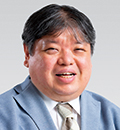Quantum Materials Field
Quantum Materials Modeling Group
We aim to advance quantum materials research and related device applications by theoretically designing emergent states of matter and understanding quantum entanglement.
Group Leader: Youhei Yamaji
Theoretical and numerical modeling of functional magnetic materials and entangled nature of the many-body electrons in quantum materials
Current Topics
In our exploration for quantum bit materials, we identified a condition revealing the quantum nature of spins in magnetization processes [1], elucidated exchange interactions in multiferroic and skyrmion materials [2,3], and proposed a mechanism for ferromagnetic–ferroelectric phase emergence [4]. We also developed methods to analyze and predict quantum materials [5], explaining the pressure dependence of Bi-based copper oxide high-Tc superconductors’ transition temperature [6], clarifying antimonene’s moiré structure on Bi(111) in collaborating with an experimental group in NIMS [7].
Outline of Research
Quantum materials are attracting increasing attention for their potential in nanoarchitectonics, with information carriers—ranging from charges and spins to composite excitations and fractionalized particles—serving as their fundamental elements. Our research focuses on the theoretical and numerical analysis of these carriers, examining their emergent properties (including quantum entanglement) to advance their application in quantum devices.
Designing stable topological defects such as solitons, through exchange couplings among magnetic ions, is crucial for developing memory devices. Magnetoelectric couplings are also key to achieving energy-efficient device operation. Our Quantum Materials Modeling Group integrates theoretical methods with computational simulations to tackle these challenges.
References
- S. Sumita, A. Tanaka, and Y. Kato, Phys. Rev. B 110 , L100403 (2024). DOI: 10.1103/PhysRevB.110.L100403
- I. V. Solovyev, J. Phys.: Cond. Mat. 36 , 223001 (2024). DOI: 10.1088/1361-648X/ad215a
- R. Ono, I. V. Solovyev, and S. Artyukhin, npj Spintronics 2 , 17 (2024). DOI: 10.1038/s44306-024-00020-9
- I. V. Solovyev, R. Ono, and S. A. Nikolaev, Phys. Rev. B 110 , 205116 (2024). DOI: 10.1103/PhysRevB.110.205116
- K. Ido et al., Comput. Phys. Commun. 298 , 109093 (2024). DOI: 10.1016/j.cpc.2024.109093
- J.-B. Morée, Y. Yamaji, and M. Imada, Phys. Rev. Research 6 , 023163 (2024). DOI: 10.1103/PhysRevResearch.6.023163
- T. Nakamura et al., Commun. Mater. 5 , 167 (2024). DOI: 10.1038/s43246-024-00615-z
Group members
-
 Youhei Yamaji・Group Leader
Youhei Yamaji・Group Leader -
 Akihiro Tanaka・Principal Researcher
Akihiro Tanaka・Principal Researcher -
 Igor Solovyev・Principal Researcher
Igor Solovyev・Principal Researcher -
 Yoshihiko Nonomura・Principal Researcher
Yoshihiko Nonomura・Principal Researcher
Links


